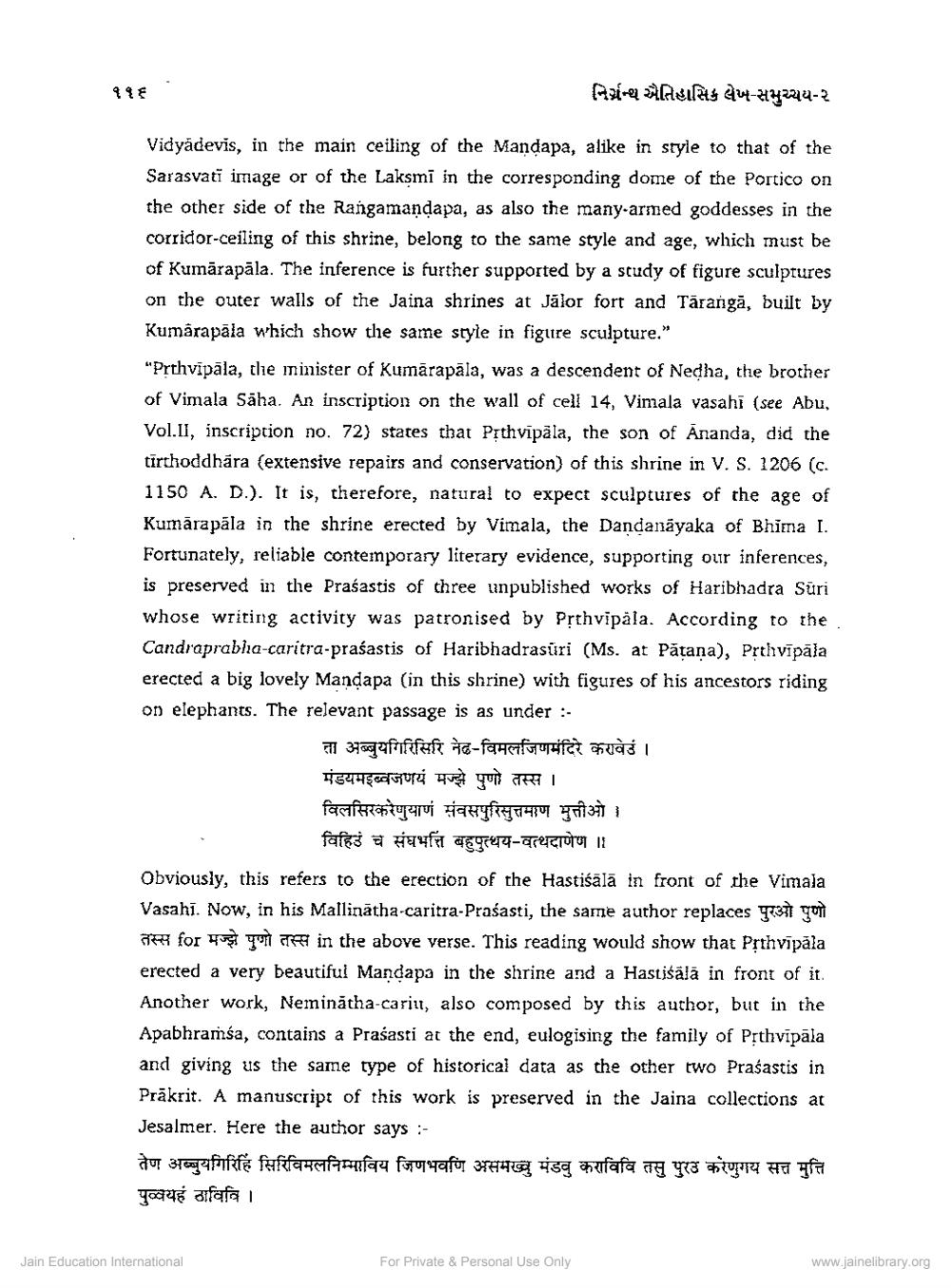________________
११६
નિર્ગસ્થ ઐતિહાસિક લેખ-સમુચ્ચય-૨
Vidyadevis, in the main ceiling of the Mandapa, alike in style to that of the Sarasvati image or of the Laksmī in the corresponding dome of the Portico on the other side of the Rangamandapa, as also the many-armed goddesses in the corridor-ceiling of this shrine, belong to the same style and age, which must be of Kumārapāla. The inference is further supported by a study of figure sculptures on the outer walls of the Jaina shrines at Jālor fort and Tārangă, built by Kumarapāla which show the same style in figure sculpture." "Prthvipāla, the minister of Kumārapāla, was a descendent of Nedha, the brother of Vimala Säha. An inscription on the wall of cell 14, Vimala vasahi (see Abu, Vol.II, inscription no. 72) states that Prthvipāla, the son of Ananda, did the tirthoddhára (extensive repairs and conservation of this shrine in V. S. 1206 (c. 1150 A. D.). It is, therefore, natural to expect sculptures of the age of Kumārapāla in the shrine erected by Vimala, the Dandanäyaka of Bhima I. Fortunately, reliable contemporary literary evidence, supporting our inferences, is preserved in the Praśastis of three unpublished works of Haribhadra Sūri whose writing activity was patronised by Prthvipäla. According to the Candraprabhua-caritra-praśastis of Haribhadrasüri (Ms. at Pătana), Prthvīpāla erected a big lovely Mandapa (in this shrine) with figures of his ancestors riding on elephants. The relevant passage is as under ::
ता अब्बुयगिरिसिरि नेढ-विमलजिणमंदिरे करावेउं । मंडयमइब्वजणयं मज्झे पुणो तस्स | विलसिरकरेणुयाणं संवसपुरिसुत्तमरण मुत्तीओ।।
विहिउं च संघत्ति बहुपत्थय-वत्थदाणेण ॥ Obviously, this refers to the erection of the Hastiśālā in front of the Vimala Vasahi. Now, in his Mallinātha-caritra-Prasasti, the same author replaces in your
e for you yon ren in the above verse. This reading would show that Pệthvipala erected a very beautiful Mandapa in the shrine and a Hastiśālā in front of it. Another work, Neminátha-cariu, also composed by this author, but in the Apabhramsa, contains a Prašasti at the end, eulogising the family of Pșthvipāla and giving us the same type of historical data as the other two Prasastis in Prākrit. A manuscript of this work is preserved in the Jaina collections at Jesalmer. Here the author says :तेण अब्ब्यगिरिहिं सिरिविमलनिम्माविय जिणभवणि असमख्नु मंडवु कराविवि तसु पुरउ करेणुगय सत्त मुत्ति पुव्वयहं ठाविवि।
Jain Education International
For Private & Personal Use Only
www.jainelibrary.org




